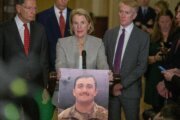WASHINGTON – It wasn’t the first time Hollie Byer was hit in the head while playing soccer. But this concussion was very different.
The 18-year-old from Olney, Maryland started having terrible headaches that would not go away. The pain lasted for months — through doctor visits and traditional drug therapy.
Then, her neurologist, Dr. Kevin Crutchfield, started talking about something new. The Baltimore-based physician sent her to Dr. Ivan Ducic, director of the Peripheral Nerve Surgery Institute at Medstar Georgetown University Hospital.
Ducic is pioneering what some consider a radical idea to treat post-concussion headaches caused by nerve damage. His approach is a new twist on an existing procedure used to treat carpal tunnel syndrome.
Using tiny incisions, Ducic moves aside or slightly shaves tissue that is pressing on the damaged nerve. He says it is like unbuttoning a shirt or tie that is so tight around the neck, it restricts breathing.
“The surgery technically undoes the pressure on the nerves so the nerve can function back again normally,” he says.
Ducic explains that decompression nerve surgery only takes about 60 to 90 minutes, is almost always done on an out-patient basis and is considered minimally invasive, requiring only a few stitches and no hair loss.
After receiving the treatment, Byer was able to return home the same day as the procedure. She says the headaches went away almost immediately.
Byer returned to her team at Our Lady of Good Council High School within a matter of weeks, and plans on playing collegiate soccer this fall.
Ducic says he is increasingly seeing more patients like Byer — kids still experiencing debilitating headaches months after a concussion on the playing field.
“Soccer is definitely high, and basketball, lacrosse, football obviously, as well. And believe it or not, even cheerleaders can have that with falls and direct head injuries,” Ducic explains.
He says surgery is an option if the headaches persist after three months of traditional treatment and a full neurological evaluation. However, he says many doctors on the front line of treating kids with concussions are reluctant to refer patients.
Ducic says the surgery is remarkably effective and has been successful in 95 percent of the kids he has treated.
“What is absolutely astonishing is to take somebody who literally can’t study, can’t work, can’t function normally, can’t live without medications, to be able to have more than 90 percent of success is truly amazing,” he says.
The Centers for Disease Control and Prevention estimates that more than 170,000 kids and teens end up in emergency rooms each year with sports-related concussions. There are no separate records kept on the number that suffer related nerve damage, prompting Ducic to say these incidents and the resulting headaches are grossly unreported.
Follow @WTOP and @WTOPliving on Twitter.







